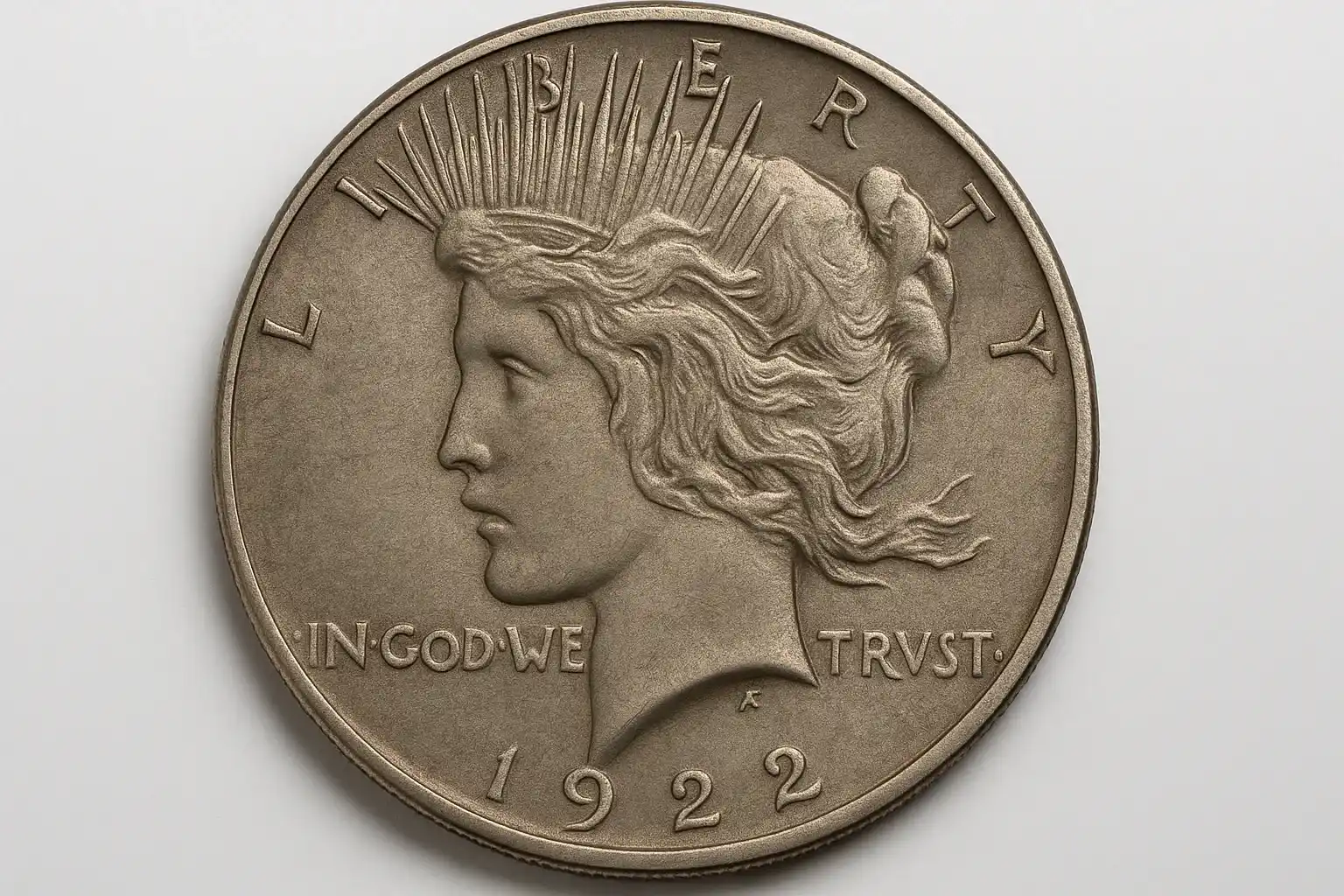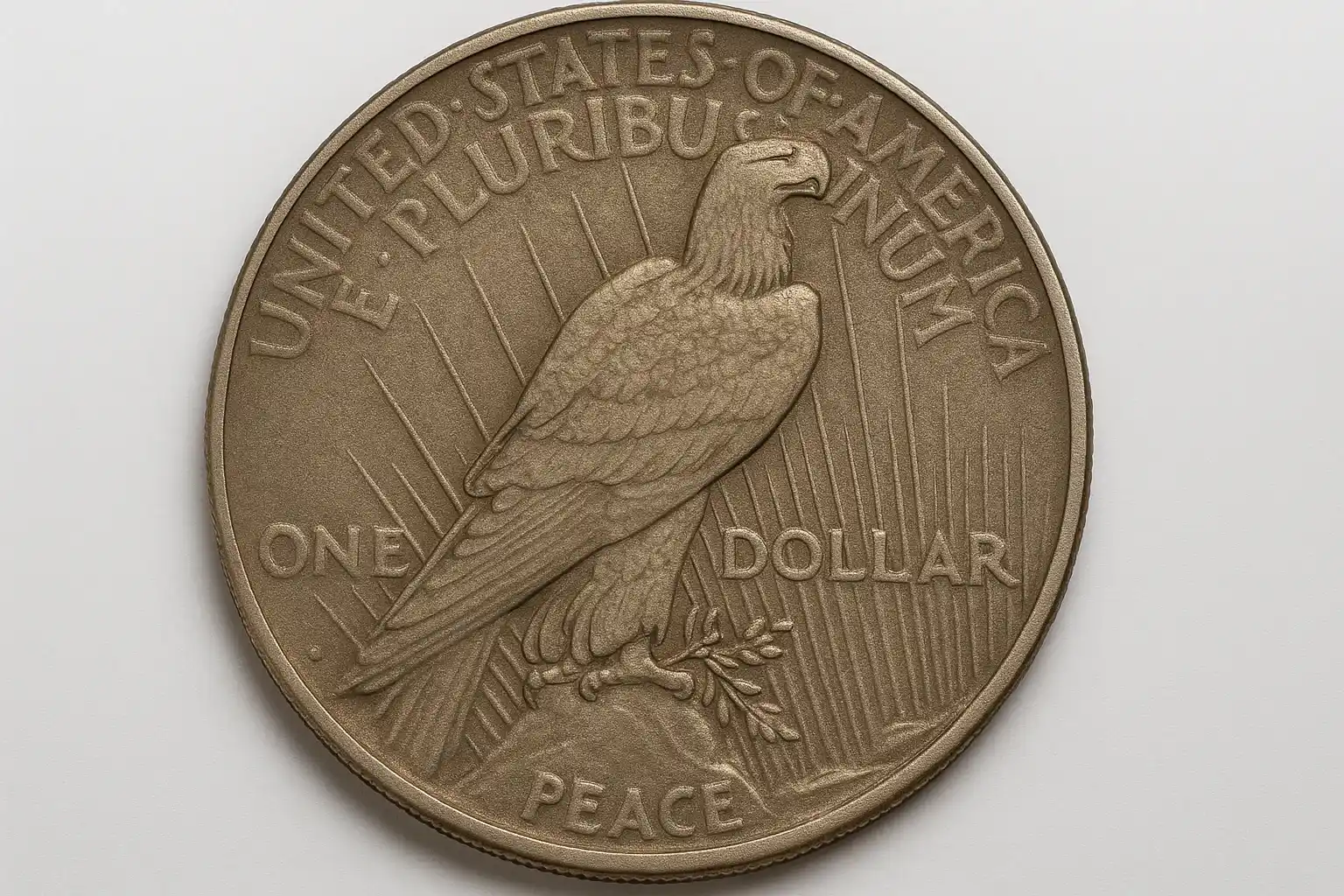The 1922 Peace Silver Dollar Overview
The 1922 dollar coin is the Peace Silver Dollar, a U.S. coin struck from 1921 to 1935. It succeeded the Morgan Dollar and symbolized America’s desire for peace following World War I. The 1922 issue is particularly significant because it became the first year the Peace Dollar was struck in very large numbers, ensuring wide circulation. This, in turn, affects the 1922 dollar coin value.
Design
Obverse: Designed by Anthony de Francisci, it features the profile of Lady Liberty wearing a spiked crown reminiscent of the Statue of Liberty. Liberty’s portrait was modeled after de Francisci’s wife, Teresa. Above is the motto IN GOD WE TRUST (with a distinctive “V” instead of “U” in TRVST, following classical lettering style). The date appears below the portrait.
Reverse: Shows a majestic American bald eagle perched on a rock, clutching an olive branch, with the sun’s rays in the background. The word PEACE is inscribed at the bottom, making it the only circulating U.S. coin to carry that word.

Specifications
Composition: 90% silver, 10% copper
Weight: 26.73 grams
Diameter: 38.1 mm
Silver Content: 0.7734 troy ounces
Edge: Reeded
Mintage Figures
The 1922 Peace Dollar had the highest mintage of the entire series, making it the most common Peace Dollar overall.
Philadelphia (no mint mark): 51,737,000
Denver (D): 15,063,000
San Francisco (S): 17,475,000
In total, over 84 million coins were struck in 1922.
Varieties
The 1922 Peace Dollar is the most common issue of the series by mintage, but it also produced some of the most significant and desirable varieties due to die preparation, minting adjustments, and experimental changes. These varieties are critical to understand because they influence value.
1. 1922 High Relief (Philadelphia)
In 1921, the Peace Dollar debuted with a high-relief design, giving the coin deep, sculptural detail. However, this relief proved impractical for mass production, as the dies broke frequently, and strikes required excessive pressure.
At the start of 1922, the Mint struck a small number of high-relief coins before switching to a revised low-relief hub for production.
Liberty’s hair above the forehead and behind the ear appears sharply raised and deeply defined. The reverse shows bolder eagle feathers and rays. Slight softness in strike may still appear on the highest points, but overall relief is visibly higher than standard issues.
Rarity: Extremely rare; only a few dozen are known.
Value: $50,000 to well over $150,000 depending on grade, with Prooflike examples among the greatest rarities in 20th-century U.S. coinage.
2. 1922 Normal Relief (Standard Issue)
After early 1922, the Mint adopted a modified design in low relief to reduce die wear and speed production.
Liberty’s profile is shallower with less detail in the hair and tiara. Reverse rays and eagle feathers appear flatter compared to the high-relief version.
Rarity: Very common, struck in the tens of millions at Philadelphia, Denver, and San Francisco.
Value: $20–$50 in circulated condition, $100–$200 in gem Mint State.
3. 1922-D “Weak D”
Produced at the Denver Mint, this variety results from a poorly impressed mint mark.
The “D” mint mark is faint, sometimes appearing as a ghostly outline or partial impression. Caused by a weak punch into the working die.
Rarity: Scarcer than standard 1922-D issues, though not rare.
Value: Collectors pay modest premiums—$50 to several hundred dollars depending on grade.
4. 1922-D “No D” (Die Polished Mintmark)
One of the most famous Peace Dollar varieties. During die preparation, excessive polishing removed the Denver “D” mint mark from at least one working die.
Obverse shows normal 1922 details. Reverse lacks any trace of a mint mark where the “D” should appear, below the “O” in ONE and above the tail feathers. Unlike Philadelphia coins, which never have a mint mark, the “No D” die exhibits subtle die markers that distinguish it as a Denver issue.
Rarity: Rare in all grades, highly sought after by specialists.
Value: $1,000+ in circulated grades; several thousand in Mint State.
5. Minor Die Varieties (Collected by Specialists)
In addition to the major varieties, specialists recognize several minor die varieties in the 1922 issues:
Die Cracks: Common in Peace Dollars due to high striking pressures. Collectors prize dramatic cracks that form “cuds” or bold raised lines across the coin.
VAM Varieties: Peace and Morgan dollars are cataloged in the Van Allen–Mallis (VAM) system. Notable 1922 Peace Dollar VAMs include doubled dies, repunched mint marks, and die breaks. Certain VAMs are scarce and carry premiums.
Off-Center Strikes: Coins struck out of collar, sometimes 5–15% off center, are collectible errors.
Why These Varieties Matter
Historical Significance: The 1922 High Relief represents the Mint’s early struggle to balance artistry and practicality.
Collector Demand: The “No D” and “Weak D” varieties are essential to a complete Peace Dollar variety set.
Market Value: While common 1922 Peace Dollars trade close to silver value, these varieties can multiply worth by hundreds or thousands of dollars.
The 1922 Peace Dollar is both a common date and a major variety year. For most collectors, it’s an affordable silver dollar. For advanced specialists, it’s a year filled with challenges: the rare High Relief, the dramatic No D, and a host of VAM varieties. In many ways, the 1922 issue perfectly reflects the Peace Dollar series—accessible to beginners, special for experts.
1922 Peace Dollar Value Table
Variety / Grade | Good (G-4) | Very Fine (VF-20) | Extremely Fine (XF-40) | About Uncirculated (AU-50) | MS-60 | MS-63 | MS-65 | MS-67 |
1922 (Philadelphia, Normal Relief) | $20 | $25 | $28 | $32 | $40 | $55 | $150 | $1,000+ |
1922-D (Weak D) | $25 | $35 | $45 | $60 | $90 | $150 | $350 | $2,000+ |
1922-D (“No D” Variety) | $1,000 | $1,800 | $2,500 | $3,500 | $5,000 | $8,000 | $15,000+ | Rare |
1922-S (San Francisco) | $20 | $25 | $30 | $35 | $45 | $70 | $200 | $1,500+ |
1922 High Relief (Philadelphia) | Rare | Rare | Rare | Rare | $25,000 | $40,000 | $75,000 | $150,000+ |
Normal Relief (Philadelphia & San Francisco): These are the most common, typically worth little more than silver melt in circulated grades. Gems in MS-65 or higher bring strong premiums.
1922-D Weak D: Collectors pay for the diagnostic faint mint mark. Scarcer than normal issues, particularly desirable in Mint State.
1922-D No D: One of the great Peace Dollar rarities. Even low-grade examples exceed $1,000; Mint State pieces command five-figure sums.
1922 High Relief: Among the most famous 20th-century U.S. silver dollar rarities. Extremely small production, with only a few dozen survivors. Prooflike surfaces increase premiums even more.

Investment Opportunities
Bullion-Level Investment
Each 1922 Peace Dollar contains 0.7734 troy ounces of silver. For bulk buyers, circulated common-date coins (Philadelphia or San Francisco, in grades G–XF) are effectively a silver play with a small numismatic premium.
Investors looking for exposure to physical silver can accumulate bags or rolls of 1922 dollars at a relatively low cost, while still owning historical U.S. coinage.
Risk: Tied directly to silver prices; these coins do not appreciate much beyond bullion in worn grades.
Condition Rarities
Although common in circulated condition, true Mint State Gems (MS-65 and above, especially Red Book–certified) are scarce.
MS-65 and MS-66 coins provide excellent growth potential as registry collectors compete for top-graded examples.
MS-67 coins are rare condition rarities; when certified by PCGS or NGC with CAC approval, they regularly achieve strong auction results.
Risk: Market for ultra-high grades can be cyclical; premiums depend on collector demand.
Key Varieties (Numismatic Blue-Chips)
1922 High Relief:
Ultra-rare, with fewer than 100 known.
Long-term demand is virtually guaranteed because of its iconic status.
Prices often exceed $100,000 in high grade, making it a trophy coin for advanced collectors.
1922-D “No D”:
A genuine rarity even in circulated grades.
Consistently attracts attention at auction, with values from $1,000 upward.
Easier entry point than the High Relief but still highly respected in the variety market.
These varieties hold long-term value and resist bullion price fluctuations.
Risk: Higher entry costs; authentication is essential, as counterfeits exist.
Diversified Strategy
Collectors and investors often take a tiered approach:
Circulated 1922 dollars as silver reserves.
Certified MS-65 or MS-66 common-date coins for mid-level growth potential.
High Relief or “No D” varieties as cornerstone rarities for long-term appreciation.
Outlook
The 1922 Peace Dollar will likely remain a cornerstone of both bullion-related collecting and advanced numismatics. Its sheer popularity, combined with the dramatic spread in value between common coins and rarities, makes it a versatile investment. For beginners, it’s an accessible silver dollar. For seasoned investors, it offers one of the most significant variety challenges in American coinage.
Scopri anche:
In a world filled with mass-produced items and generic designs, there is a growing appreciation for unique creations that evoke a sense of creativity and imagination. Creazioni Uniche, which translate...
Unlock the secrets to selecting the perfect handmade gifts with our comprehensive guide. Explore how understanding the recipient, supporting artisans, and thoughtful presentation can transform your gi...
Dive into the rich world of traditional crafts with Handmade Treasures. Learn about the diverse artistry, cultural importance, and the therapeutic benefits of crafting. Discover how supporting these a...
© 2024 Handmade Treasures
All rights reserved.
Our Partners:
Free phone number tracker



